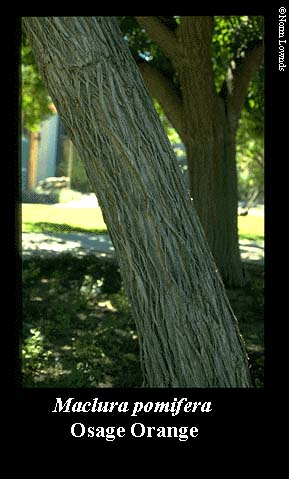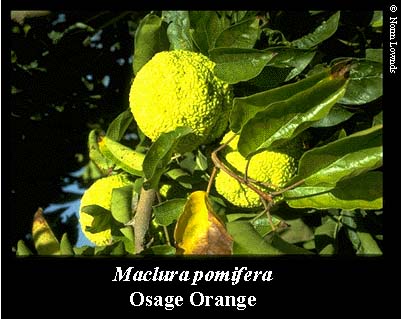Osage Orange
Maclura Pomifera


Maclura pomifera: Osage-Orange, Hedge, Hedge Apple, Bodark Susan Borecki, AGRO / HORT 100G Spring 2002
Osage-orange trees are native to an area centered on the Arkansas and Red River valleys in southern Oklahoma and northern Texas. They derive their name from the Osage Indians. These people prized the wood from the osage-orange for its strength and elasticity. They used it primarily for making hunting bows and war clubs. The wood is strong and so dense that it will neither rot nor succumb to the attacks of termites or other insects for decades. Dried for firewood, it is the next best thing to coal.
During the 19th and early 20th centuries the tree was planted throughout the United States probably more than almost any other tree species in North America. Before the invention of barbed wire in the 1880's, many thousands of miles of hedges were constructed by planting osage-orange trees closely together in a line. The saplings were aggressively pruned to promote bushy growth. Osage-orange can be either a shrub or a tree, depending on its surroundings. Standing alone in full sun it will become a multi-stemmed shrub; with neighboring competition it can become a single-stemmed tree. Although it is the only member of its genus (a monotype), it is cousin to the mulberry family (Moraceae). Osage-orange possesses strong form, texture, and character, maturing with a thick, gnarled appearance. The trees are easily recognized by their glossy, lance-shaped leaves and their short, stout thorns. Generally they live a trouble-free life in the home landscape. Preferring open sunny areas, they can grow in a variety of soils and is considered hardy to Zone 5. Occasionally they may be attacked by leafy mistletoc, verticillium wilt, fungal diseases, stem borers, scale, and some rodents. Considered as one of the most drought-tolerant trees and shrubs, an established osage-orange will need supplemental watering only twice a month during the summer.
The osage-orange averages a height of 30-25 feet, but heights of more than 60 feet have been recorded. The tallest osage-orange stands at Red Hill, the home of Patrick Henry in Brookneal, Virginia. Both a National Champion and a member of the American Forestry Hall of Fame, this 400-year-old specimen has an eighty-five foot span and stands sixty feet high. Generally, the tree's circumference reaches 4 to 7 feet, although 1.5 feet is the average, and the crown spread reaches up to 60 feet (with an average of 25 feet).
The skin of the fruit has a pleasant, orange-peel smell. It is a large, dense, green wrinkled ball up to 6" in diameter that often persists on the tree after the leaves have fallen off. "Hedge apples" contain a chemical (2, 3, 4, 5 - tetrahydroxystilbene) that has been proven to repel many bugs: cockroaches, crickets, spiders, fleas, box elder bugs and ants. Cut the fruit in half or crush it on the driveway with your car, then place it in a dish set in the pest problem area. One piece will last for a few weeks.
Bibliography
Ball, J. "The Versatile Osage-Orange," American Forests, Autumn 2000.